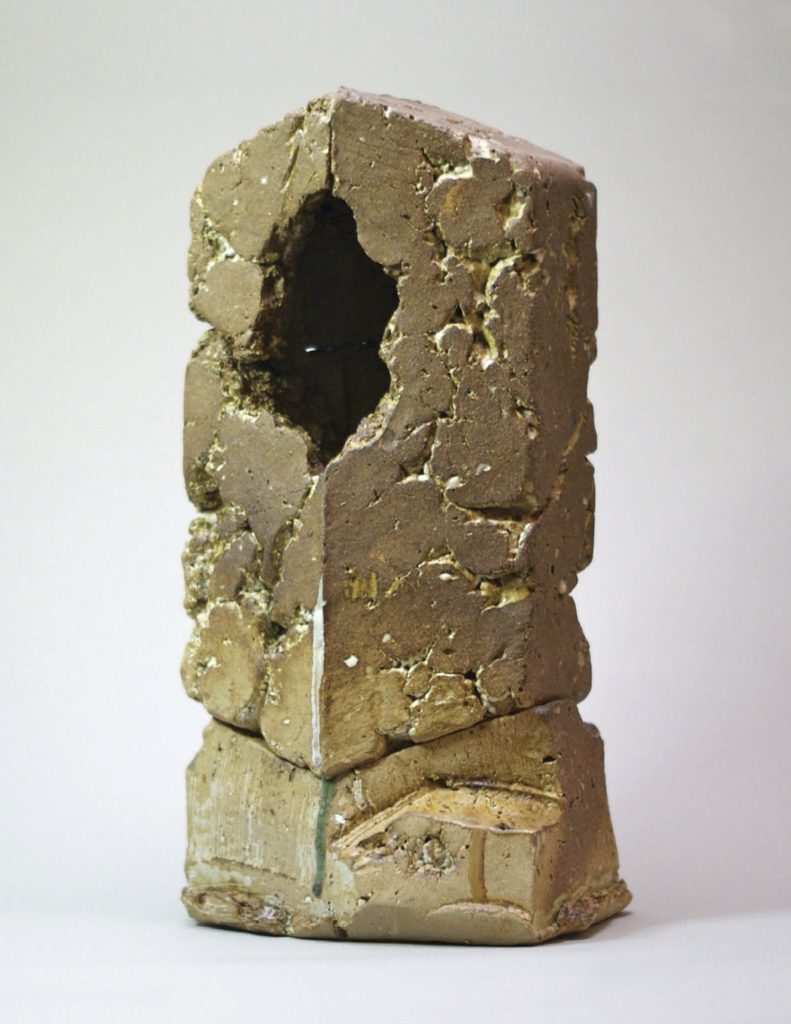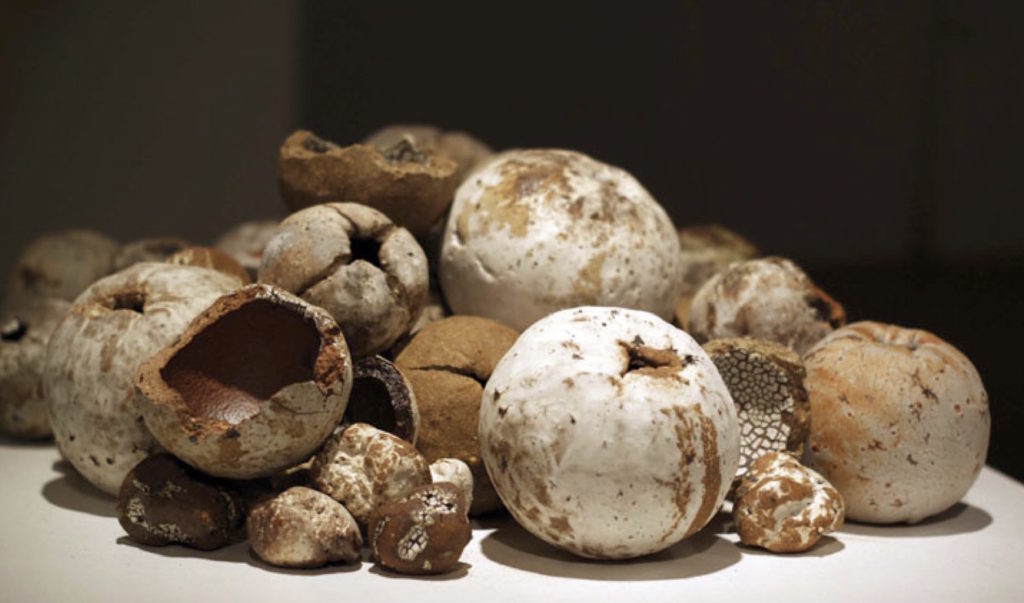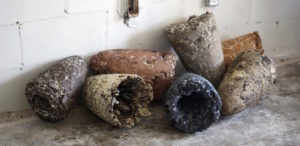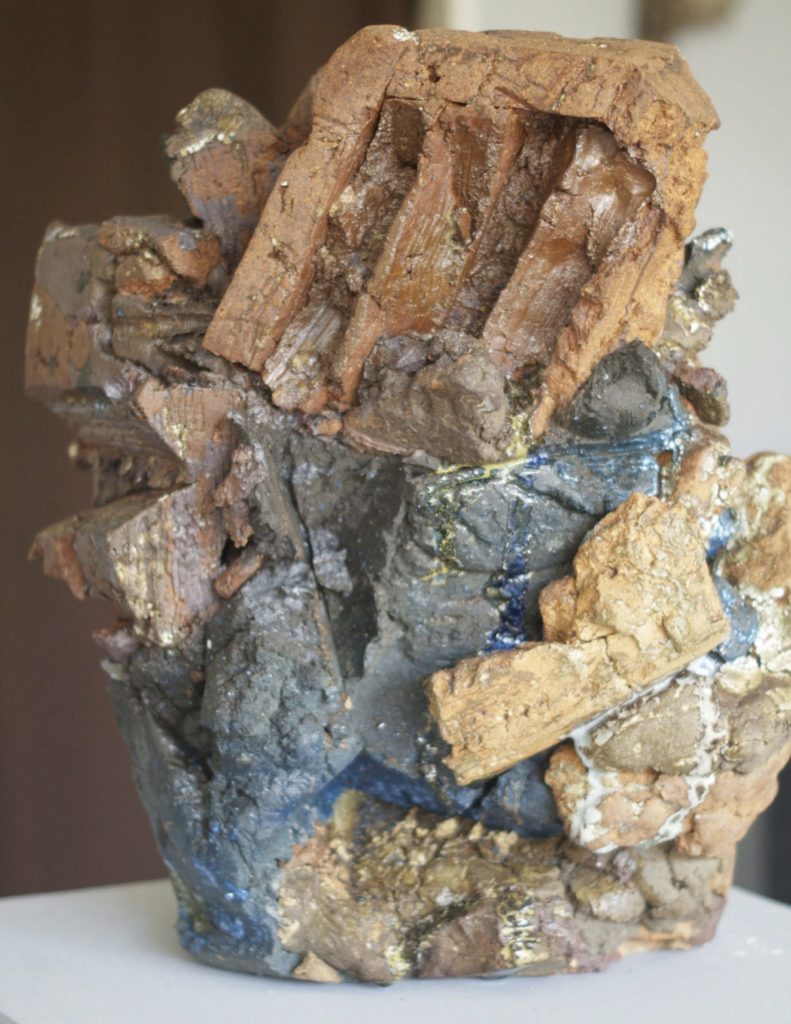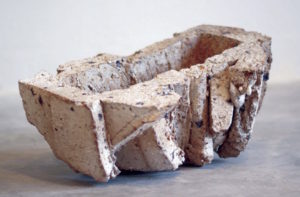Richard Munster’s ceramic sculptures walk the line between man-made and natural rock formations. His work contains natural minerals and utilitarian objects fused together. With a background in functional pottery, he creates fine art works using his technical understanding of clay. These sculptures combine the natural, soft look of the clay with sharp, deliberate cuts. Blurring the line between ancient and contemporary, Munster plays on the tradition of ceramics and discovery.
Jenn Allen: What I really like about your work is that it’s not time specific. The way I look at your sculptures is that they feel like these arti- facts that in 500 years in the future, if somebody came upon them, they wouldn’t know where they’re from and there would be this questioning. Do you think about that, especially since with ceramics there is a lot of archaeology and discovery involved?
Richard Munster: Yeah, I do. I think that anybody who is interested in the work that I’m making or is working in that vein laughs about confusing archeologists. Even to this day, I’ve had a number of people who respond to the work saying ‘Oh my gosh, it looks like it should be in a natural history museum, but…’ and the sentence kind of ends there. I make works that look like it should be something that came out of the ground but obviously isn’t. It is a really delicate balance, but it’s interesting to me.
How do you decide what clay bodies you use?
Over the last couple of years I’ve learned a lot more about the specific materials I’m using. So many of the materials that we use in the ceramic tradition or in the ceramic spectrum, whatever you want to call it, are regular, everyday, materials that exist around us that are common in industry, whether that’s toothpaste, or sandbags for levees, or paper, or whatever it maybe, they’re all mineral based products. To be able to incorporate those into the work that I’m making is both technically interesting to me, but also lends to the vocabulary of the material itself. Whether it’s auto glass, whether it’s beach sand, beach shells, or any number of other materials that I may find along the way, I use those because I know they’re available. I think the vocabulary that comes from that material is something that I’m beginning to do more intentionally, but I really enjoy reading into it after the fact.
How do you become inspired by these everyday materials and decide to use them?
The honest answer? I think anybody that fires kilns is like ‘Oh shit, I can melt that. Let’s do this!’
A lot of your sculptures are either unglazed or they look more raw and natural like they came out of the ground. Why do you choose to go that route instead of more traditionally glazing them or coating them with some kind of finish?
I have a background in functional pottery and traditional work. Glaze is an amazing and beautiful thing, but it has to be used appropriately. It would be really easy for me to say ‘I like the work raw because it speaks directly to the quality of the material’ and that is true. That clay is its own skin. That skin has so many different shades and textures that it can take of its own accord. Glaze often hides those. But I think, more than that, the natural quality of the material is one of the things that draws me to working with it. So if I am using glazes, it’s probably to highlight something or because I think that bold and beautiful color, or texture, is called for.
Talking about the work itself, the form of the work, I find that they’re almost romantic. They very much have a relationship with earth and man. Do you see within the clay the figure, the shape, or is it more of a relationship that is occurring over time?
That’s a good question. I think I see a lot of the forms that I want to make prior to going into it, and it’s impossible for me not to see them in clay. This is my material. The surface, the color, the texture – it is something that is inherent to my mode of thinking when I begin a body of work, or begin a project. To go back to the word romantic, I think it’s interesting. To romanticize something is to imbue it with all of the best and almost impossible qualities it could have. And it’s really easy when you’re romanticizing something to come from the opposite direction and cut deep right under- neath it. It’s really easy to see the bitter, to see the unfair, to see a lot of the not right that comes from the romantic side of something. So, walking the line between those two is really important to me.
That makes a lot of sense because you do have a lot of sharp edges with more natural, not necessarily rough, but more organic edges.
Right. We idealize a lot of things, and I don’t want to say that I kind of point at or laugh at those but I definitely want to draw into question idolatry or reaching for ideals. And let’s bring us back down to earth and look at the other side of the coin. Visual media is so fun because it gives you the opportunity to do that without having a bunch of words get in the way. Sometimes my titles will point in the direction of what my work is getting at, but then those tend to shift with my thinking as well, which is kind of fun.
I could imagine that it would be hard to give titles to your work without giving too much away.
I’ve really begun to love titling the work. Sometimes I will make work based on a title, or at least challenge myself to do as much. But often times the process of making the work I begin to make correlations between either objects or cultures, whether those are buildings, or cycles, or behaviors. My thoughts on those tend to crop up a little bit in my titling.
What made you decide to hang some of your heavy ceramic pieces on the wall?
Oh gosh. I think about caves and photographs of mountainsides or when you’re driving down the highway that they’ve been making by blowing the rock of the face of the mountain, something about that mass of rock jutting from an otherwise clean planar surface
is amazing to me. So I made it a personal challenge over the past year or so to be able to get away from the floor or the pedestal and to get the work on the wall. Not only for ease of placement in terms of homes, not a lot of people have room for sculpture, let’s solve that problem, but more than that. My visceral response to seeing rock jutting out of the wall in an otherwise clean environment is really meaty to me and it makes me happy.
You don’t see that in Florida, so it’s interesting that that inspires you.
And I love that you say that because so many people are like ‘Oh, you know I’m inspired by my environment’ and of course I’m inspired by my environment but I’m more inspired to go to the beach than I am to make work about the beach. We talked about romanticizing things. I see all the pictures of Utah, I’ve been to Washington State, I’ve been to a number of beautiful mountainous regions where the landscapes are completely different than Florida and I romanticize those. I don’t have to live in the mountains; I don’t have to deal with the small patch of sky or big fucking boulders in my yard that I don’t want there. To some degree, making the work that feels like big jagged stones is like the countryside or part of the world that I don’t live in.
It’s like bringing the rest of the United States to you.
Yeah, I can’t necessarily go there all the time so I will bring it to me.
Tell me a little bit about your career as an artist. Where did you start and how did you end up with ceramics being a predominant form of your art?
I stumbled into making pottery in high school classes and it wasn’t until a couple of years outside of that that I realized I really enjoyed what I was doing and was invested in it. I spent a number of years doing markets, fairs and festivals, selling functional work. It wasn’t until probably a good eight years into pottery making that I started pushing the boundaries of what was functional or what was useful and was thinking a lot more about the materials I was working with and melting. Just having fun making a mess with it.
I know that you’ve done some sculpture work outside of ceramics; do you want to talk about that at all?
I would love to do more sculpture work outside of ceramics. I find myself drawn back to the work that I’m doing. A, because I love it and B, because the ability to market work, the ability to make work that is an object, for lack of a better term, that can sell and go somewhere. It’s easy to get stuck on that. I did entertain some work in sculpture for a while that was sight specific or installation based, and for me, it dealt with the same issues. I would say that I worked in the same fashion in handling materials that I do in ceramics, but it was with temporary materials. I was making mandalas, and targets and a lot of those were out of found materials, or the combinations of local materials. Dirt from parking lots, leftover food, shredded paper, junk mail. Kind of like the detritus of life and shit that passes through our lives and hands on a regular basis that you don’t deal with. I was gathering a lot of that and using it in temporary installations.
So you were taking something that might otherwise be discarded or un- seen and making it prominent for the viewers.
Right, but I was trying to pick on things that I felt were important in terms of cycles of objects that we, I don’t want to say overlook, but take for granted and put those in the spotlight. Not in any pointed way; I wouldn’t say it was ecological or environmental or I wouldn’t say that it was socially conscious work of any sort, but it’s more like let’s look at the fact that this is something that we do all the time and it’s easy to forget that that’s a part of the regular cycle.
You said you had a ‘functional’ background in ceramics. What made you switch from functional work to something more sculptural and dis- play-worthy?
It’s funny that you say switch. I’ve been focused on the sculpture work for the past two or three years now. At the same time, I kinda miss making pots. Functional work is powerful. It’s not décor. It doesn’t sit on your shelf. People put their lips and their hands and their fingers on those objects. They choose to buy them because they love them. They’re intimate objects and they’re really powerful in a way. They’re a part of your domestic and intimate life. There’s a power there that I think is really sublime. It goes past bold or brash statements, or whatever it is that you can do with sculpture work. And more than that, the cycle of going and sitting and making pottery, working on the wheel, gives it time for the work I’m doing in sculpture to charge itself again. It’s kind of like a period of reflection. By all means, making pots is not an easy task, especially making good ones.
The rhythm of working and the pace, and just your mindset, when you’re making work on the wheel, when you’re making the functional work for daily use is just different, and allows for both a physical and a mental reflection. Utilitarian work trains your eyes and it trains your hands way more than you realize. The nuances and the subtleties in pottery are so important. You pick it up and you use it. Is it comfortable, is it balanced well? Do I want to touch it with my lips?
Making that work visually and kinesthetically trained my hands and my eyes in terms of the work I make in sculpture. I continue to go back and make batches of pots on a fairly regular basis. I think this is probably the longest now that I haven’t sat at the wheel. Now that I wrapped up the work I was doing at UCF I look forward to taking the opportunity at home to sit and make batches again. I have no intention to quit doing that. It’s just a matter of how often it works its way into my cycle of work.
If someone wanted to view your work locally where would they be able to find it?
I have two spaces. A place called FAVO or Faith Arts Village Orlando; they do monthly events on the first Friday of every month. I have room ???, it’s full of my work, and room ??? is a kind of gallery space that I utilize for hosting guest artists. These are younger people in Orlando that I think make really outstanding work and have it together enough to put together a small solo exhibition.
Have you seen your art evolve in the past couple of years or the past couple months? Where do you anticipate your art going in the next couple of months?
Man, I’ve definitely seen an evolution in the work that I’m making. I think that growth is, I don’t want to say inward, but it’s like the aesthetic that I’m looking for is beginning to find a home and I’m learning to make work from the ground up as opposed to just making work and looking at it in hindsight. If I can just keep that momentum moving, that will keep me happy for the next ten years. I just want a place to work and the time to do it.
You can see more at: RichardMunster.com

